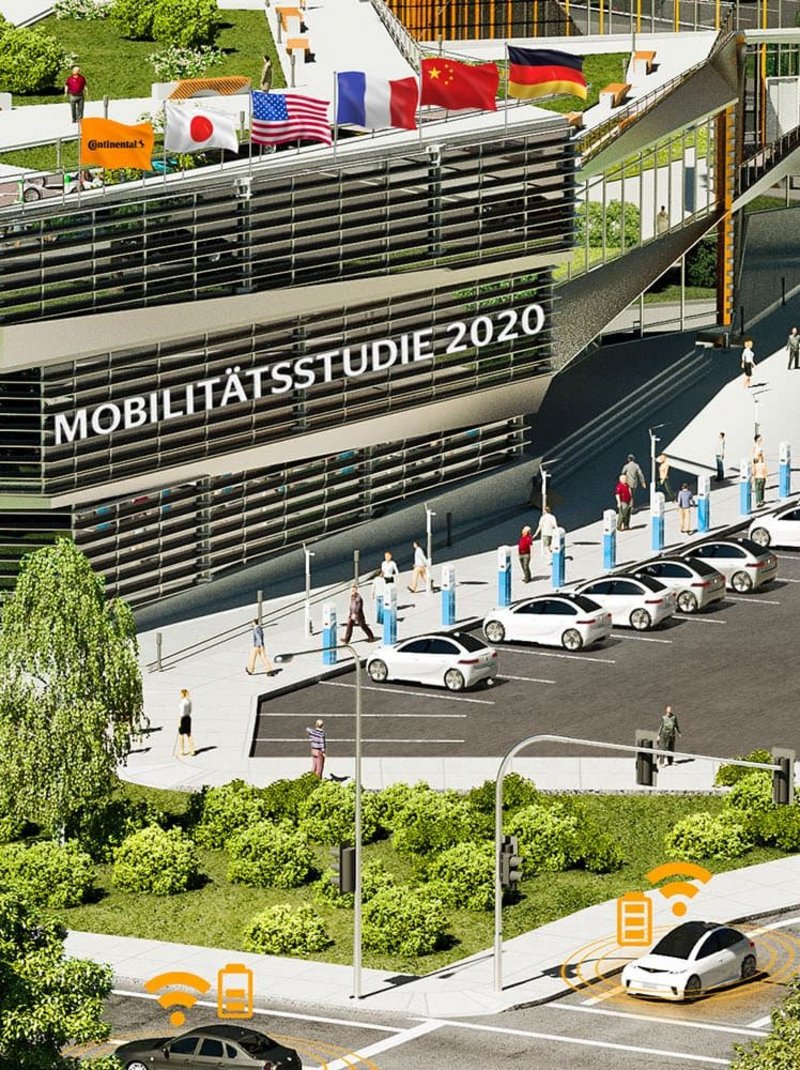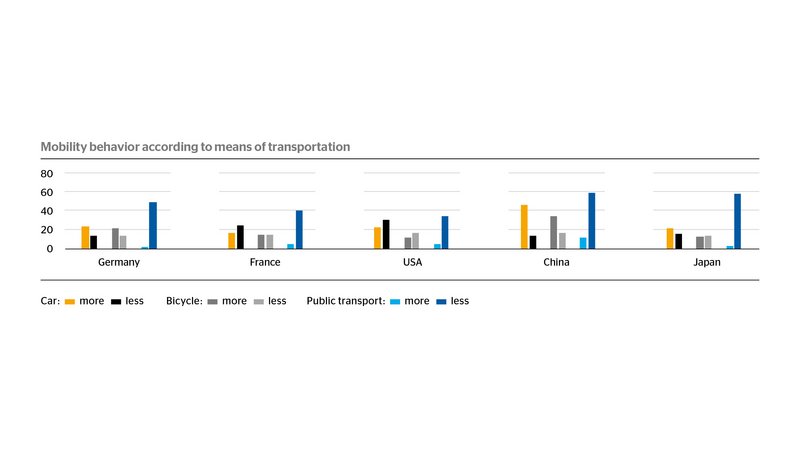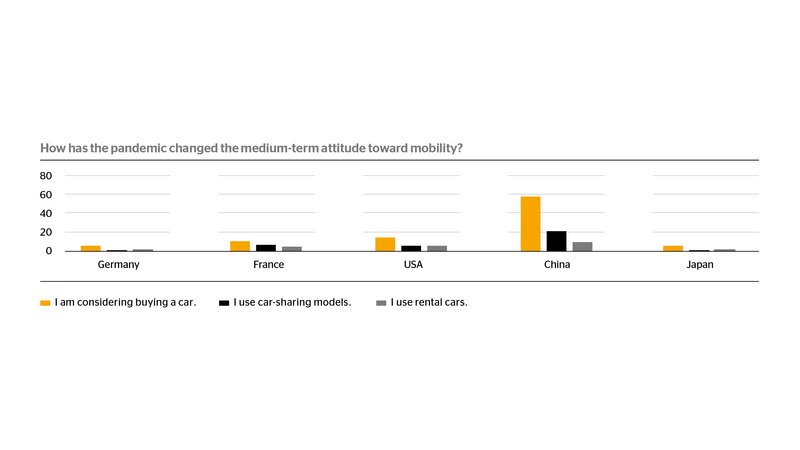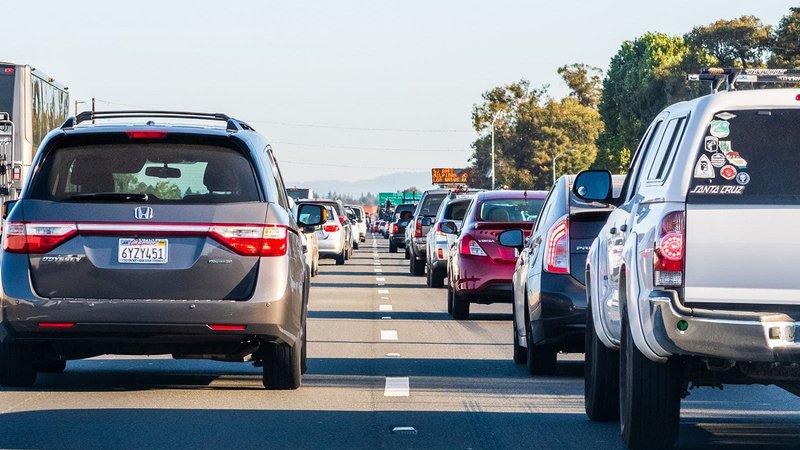The Continental Mobility Study
The Continental Mobility Study

“This is Radio 1871 with the latest traffic information. The German railways and public transport services are operating during the pandemic, but passenger numbers have declined significantly. There is currently less congestion across the country. The traffic is even free-flowing at the Kamener Kreuz intersection. You can however still expect delays between Heidenheim and Langenau due to long-term roadworks. On the bright side, Berlin has several kilometers of new bike lanes in both directions between Neukölln and Friedrichshain.”
We spend lots of our time on the road. Mobility is a basic prerequisite for social inclusion, access to the labor market, societal progress and even for maintaining emotional relationships. According to the Federal Ministry of Transport, the combined travel of all Germans amounts to 3.124 billion kilometers a day, excluding the restrictions imposed through the pandemic. And according to calculations by the European Commission, private households in the EU invest 1 trillion euros a year to get from point A to point B. The means of transport that people choose is influenced by various factors: In the current coronavirus pandemic, health concerns are at the forefront, but comfort and quality of life, safety and the desire for an intact environment also play a role. To have a chance of success, new mobility concepts must answer these needs.


Mobility must fit into the reality of our everyday lives
These days, many of us are spending more time than usual at home. However, being able to travel to other places at any time fundamentally gives us a sense of freedom. The car is still people’s first choice because it allows flexibility, permits individual mobility and is suitable for long distances.
This is the clear result of the Continental Mobility Study 2020, for which people in Germany, France, the US, China and Japan were surveyed on how they get around. Well over 80 percent responded that they own a car that they drive regularly. Family or friends’ cars are relevant for 14 to 20 percent of people. New sharing concepts such as ride-pooling or ride-hailing do not yet play a relevant role overall. While a slight increase has been recorded in large cities, especially in the US, they are still far from going mainstream. In China, around ten percent of people say they use these services regularly. However, more people here than in any other country worldwide are thinking of buying a car. Sharing models may therefore become even less relevant in the future.
Individual mobility is an elementary part of a prosperous lifestyle and has become indispensable for everyday life, especially in rural areas. Concepts for the future must take this into account so that they fit into the reality of people’s lives. But it’s also clear that mobility will change. After all, in large cities, 30 to 40 percent of driving is spent looking for parking spaces, while advances in digitization and sustainability are becoming increasingly important factors. Let’s take a look at people’s current mobility habits during the still ongoing pandemic.
During the Crisis, People Prefer to Travel Alone
Owing to the outbreak and spread of the coronavirus, people are traveling differently than before. Although mobility is decreasing overall, the desire for individual mobility has become even greater.
Almost half of respondents in China say they travel more by car. In Germany, a quarter of the respondents answered the same. Even in France, where freedom of movement and therefore mobility were particularly severely restricted, 16 percent of the population used their cars more frequently than before the pandemic began. The US (22 percent) and Japan (21 percent) show similar figures.
Bicycles have also become more popular and have gained in importance. At 34 percent, this figure is particularly high in China, followed by Germany at 21 percent.
In contrast, the situation is quite different for public transport services, which are generally not the first choice because they are perceived as a potential source of infection. Half of Germans say they use public transport less often than before. And the figure is even lower in China and Japan.



How individual mobility can vary in individual cases illustrates the example of Vivian G.(27). She lives with her husband and child in Frankfurt, Germany. They chose not to live in the city center, but in the Bergen-Enkheim district, which is a little further out. The young family doesn’t currently use public transport or the train at all, so another solution was needed. “We feel that we belong to the Fridays for Future generation. That’s why a car was out of the question for us; we do all of our shopping and commuting using an electric cargo bike. Our child loves the trips by bike and we’re also delighted with the purchase because we spend lots of time in the fresh air, don’t have to look for parking spaces, and because it’s cheaper than a car,” says Vivian. If they do want to drive longer distances, they use a car-sharing service. Having their own vehicle is not an option for them. But if they’re left no other choice in future, they would opt for an electric car.
The question is whether the desire for individual mobility will be maintained after the crisis. Some survey results suggest this: In fact, between 6 percent (Japan and Germany) and 15 percent (US) of respondents report that they have bought or are considering buying a car – a medium to long-term decision. In China, where the proportion of car owners is still significantly lower, the figure is as high as 58 percent.
Meghann McCallister (39) from Bainbridge Island near Seattle, USA, uses waterway transportation to navigate short distances within her region. “Before the COVID-19 pandemic, our daily lives were very diverse in terms of mobility. This included the school bus and our own cars,” says Meghann. “Right now, my husband and I work from home and the kids are doing virtual schooling. When we want to go to the city, we walk, bike or take the public bus to the ferry terminal which shuttles us to Seattle.” Meghann lives with her family eight miles outside the North American metropolis, on one of the nearby islands, which can be reached by ferry or over a bridge. With two children, it was important for them to have more space around their home and greater recreational opportunities. The pandemic will leave lasting changes in mobility, including Meghann’s family, “Before the pandemic, we had two cars because of our different working hours and the kids’ different schedules and activities. Now, one car is enough for us, since we spend most of our time at home. We now plan our trips ahead, have a new work-life balance and don’t intend to buy a second car when circumstances return to normal,” Meghann explains.
The pandemic makes us aware that disasters can turn our world upside down. What is important, as the German National Academy of Sciences Leopoldina writes, is to build resilience – the ability of societies to withstand adversity and regenerate. Climate change is the next acute threat to which we must find answers, and the issue of sustainability is coming to the fore. According to an estimate by the German Federal Ministry of Transport, there will be 4 billion vehicles worldwide in 2050, compared with 1.2 billion at present. This means that we urgently need to think about what a climate-friendly energy supply for the transport of the future might look like.

Electric, Individual and Sustainable
Electric mobility is seen as a key future concept for making individual transportation more sustainable. Since 2013, the share of car owners who can imagine driving a purely electric car in the future has increased in most countries, significantly in some cases. Despite this, sales of electrically powered vehicles – both in Germany and almost all other parts of the world – are well short of expectations and below the scale needed to achieve the planned greenhouse gas emission reduction targets.
Around one-third of respondents in Germany said they could imagine buying an electric car in the future, compared with only 17 percent back in 2013. But even in France (57 percent) and the US (50 percent), at least half of the population cannot see themselves driving an electric car. In Japan (46 percent), the proportion is only slightly lower. Despite an increasing willingness to consider the purchase of an electric vehicle, the fact remains that the majority of people cannot concretely envisage this for their own everyday lives.
Overall, the most significant reason that speaks against electric cars for most people is range anxiety. In four of the five countries surveyed, the lack of charging stations is the key reason against electric driving for people. France is the only country where price is what discourages most people. Otherwise, it is striking that the reservations are similar worldwide. The four most important arguments of electric car skeptics are the same in all five countries: low availability of charging stations, low range, forced charging breaks on long trips and the high price compared to cars with combustion engines. For many, this excessively restricts the freedom that they expect from car ownership.
In an international comparison, it is particularly noteworthy that one third of respondents in Germany also state that the technology is not environmentally friendly as an argument against electric mobility, significantly more than in any of the other countries surveyed.
This clearly suggests that, in addition to “hard” factors that can be changed by policymakers and industry (including price, technology, infrastructure), the perception of the technology also needs to be changed through information campaigns.
But there is also cause for hope: According to the Federal Motor Transport Authority, new registrations of fully electric passenger cars in Germany had risen by 365 percent last October in comparison with October 2019. At the same time, new registrations of gasoline-powered cars fell by almost 30 percent in October. But if we look at the absolute figures, the difference is still huge: 115,000 gasoline-powered cars hit the German roads in October and only 23,000 electric cars.

The Empire of Electric Mobility
A decisive push for electric mobility could come from China, as the results of the Continental Mobility Study suggest. As an “automotive growth market,” China has for many years been a key sales market for automobile manufacturers from around the world. The survey results show that in no other country has the importance of private transport increased as significantly as in China: 46 percent of respondents use cars more frequently than before. In Germany, at 23 percent, this proportion is half as high. This trend is set to continue. Almost 60 percent of respondents say they have purchased or are considering purchasing a car.
Rural people are the driver in the statistics related to individual mobility in China.
But there are also big differences in mobility habits within China, as Lilian Xu (37) from Shanghai explains: “The statistics show that people in rural areas are the driving force behind individual mobility in China. There was a big backlog in demand here, and it shows in the sales figures for private cars.” In Chinese cities such as Shanghai, citizens continue to make greater use of public transport due to time constraints – even in times of pandemic. On the one hand, because of the very well developed local transport network of subways and buses and, on the other, to avoid the traffic jams during rush hour.
Electric mobility has been around in Chinese cities for quite some time, as Lilian reports: “Many private cab and ride-sharing providers rely heavily on electric vehicles, and electric scooters are a familiar part of the cityscape for us.”
Moreover, the openness to electric vehicles here is unparalleled in any other country: 86 percent of respondents in China can imagine buying an electric car. This also means that the German automotive industry has to keep up in order to tap into the fast-growing Chinese electric mobility market and not be left behind by competitors such as Tesla and local suppliers. In fact, there is still plenty of scope for growth. According to the German Automobile Association (VDA), German automobile manufacturers have a market share of only twelve percent in China. Despite this, the People’s Republic is by far the most important sales market for many German car manufacturers.
Conclusions: Individual mobility is very important, bicycles and other alternative means of individual transport are now playing a greater role, but the preference for getting around in an automobile is also undiminished. These trends are further amplified by the coronavirus pandemic. Electric mobility is a promising option for making mobility sustainable. However, infrastructure issues still need to be resolved in order to pave the way to the mass market. Reservations among consumers also need to be dispelled.
“And that brings us to the end of our traffic report. Have a good trip, whether over land, water or in the city. And stay healthy.”